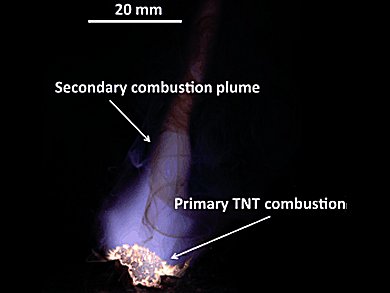A flare is a pyrotechnic producing a brilliant light or intense heat without an explosion. It is used for signalling, illumination, or defense in civilian and military applications. Aircraft are facing a steadily increasing threat by infrared guided ground-to-air and air-to-air missiles. Common first- and second generation missile seekers track the hottest spot in their field of view. So, most advantageously, they can be mislead by flares ejected from the aircraft that yield hot flames of T = 2000–2500 K and a graybody type signature. Typical payloads comprise magnesium/fluorocarbon compositions.
True aircraft do not exhibit a graybody-type signature. They radiate selectively in the range of the combustion products H2O and CO2. Today’s so-called two-color seekers for advanced missiles are able to distinguish between hot spot flares and true targets.
Ernst-Christian Koch, NATO Munitions Safety Information Analysis Center (MSIAC), Bruxelles, Belgium, and colleagues from Fraunhofer Institute für Chemische Technologie (ICT), Pfinztal, Germany, report on the use of mixtures of 2,4,6-trinitrotoluene (TNT) and KClO4 in spectrally matched decoy flare compositions.
TNT functions as energetic fuel and melt-cast binder. Although TNT is a high explosive, its compositions with KClO4 are less sensitive to friction impact and shock and possess greater thermal stability than common pyrotechnics or double base propellants.
The TNT/KClO4 pyrolant system is more easily and safely processed through established melt-casting operations. It is more energetic than any of the hitherto considered fuels in KClO4-based formulations, thus offering both high spectral efficiency and high color ratio.
Work is in progress to explore the use of TNT in other melt-cast pyrotechnic formulations.
- 2,4,6-Trinitrotoluene: A Surprisingly Insensitive Energetic Fuel and Binder in Melt-Cast Decoy Flare Compositions,
Ernst-Christian Koch, Volker Weiser, Evelin Roth,
Angew. Chem. Int. Ed. 2012.
DOI: 10.1002/anie.201204808
Also of interest:
- E.-C. Koch on Energetic Metal-Fluorocarbon Materials and Munitions Safety,
Julia Stuthe, Vera Köster,
ChemViews magazine 2012.
DOI: 10.1002/chemv.201200056
Dr. E.-C. Koch, specialist in energetic materials for NATO, talks about the fascination of fireworks and society’s need for explosives




